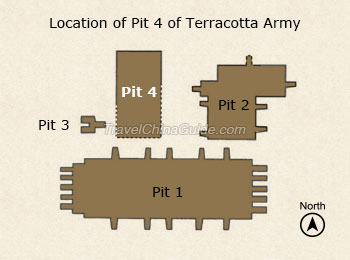Pit 4 of Terracotta Army Museum
Is it the pit for Central Army?
Some archaeologists speculate that the Terracotta Warriors Pit 4 is the planned central army, which was probably not built due to the outbreak of peasant uprisings in the late Qin Dynasty (221 BC – 207 BC). This conjecture has been supported by many scholars. Archaeologist Yuan Zhongyi, the first curator of the Terracotta Army Museum, pointed out that in ancient times, there was a saying that “three armies in battle”. According to the current excavation discovery, Pit 1 could be regarded as the right army, Pit 2 as the left army, and Pit 3 as the military headquarters. According to its location, Pit 4 is right in the middle of the whole army.
 |
| Location Map of Terracotta Army Pit 4 |
If it is indeed an unfinished pit, then what kind of military force was planned for Pit 4 of Terracotta Army? The answer should be cavalry. Why?
1. Terracotta Warriors Pit 4 is located to the left of Pit 1, behind Pit 2, and in front of Pit 3. This position is right where mobile troops are arranged on the battlefield, not logistics troops.
2. The ancestors of the Qin people were good at raising horses. It was said that Qin State had already had “tens of thousands of horses” by the time of Qin King Hui, about 100 years earlier than the construction time of the Terracotta Army.
3. After the unification of China, Emperor Qin Shi Huang immediately launched troops against the northern nomadic Huns, and a powerful guarantee for the expedition to the Huns was a fine cavalry. It is obviously impossible that the Terracotta Army, which was modelled on the most elite army of the Qin Dynasty, does not have an independent cavalry unit. Therefore, the most likely layout of pit 4 is a cavalry array.
Is it a trench used to collect earth?
Then what was the Pit 4 of Terracotta Army Museum used for? Some historians believe that Pit 4 was simply a trench used to collect earth for the construction of other pits. The reasons are as follows:
1. Pit 4 does not have the ramp gateway the other terracotta warriors pits have;
2. The earth accumulation in the pit was not formed naturally, but was backfilled deliberately later;
3. It was much wider from north to south than from east to west, thus not in the same direction as the other three pits.
4. If it is a terracotta warriors’ pit, it should have been designed and constructed together with the other three pits, rather than being empty.
5. Not a single piece of relics from Qin Dynasty, even tiles have been found in the Pit 4.
Terracotta Warriors Tour: One-day to visit Terracotta Warriors and Horses and more
More Xi'an Tours